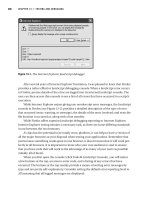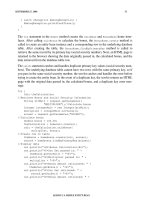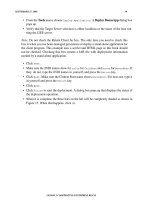Writing Enterprise Applications with Java™ 2 SDK, Enterprise Edition phần 10 ppt
Bạn đang xem bản rút gọn của tài liệu. Xem và tải ngay bản đầy đủ của tài liệu tại đây (41.35 KB, 11 trang )
LESSON 7 JDBC TECHNOLOGY AND BEAN-MANAGED PERSISTENCE
106 SEPTEMBER 27, 2000
Change the CalcBean and JBonusBean Code
Because BonusBean provides its own SQL code, the CalcBean.calcbonus method, which
creates
BonusBean instances, has to be changed to throw java.sql.SQLException. Here is
one way to do make that change:
public class CalcBean implements SessionBean {
BonusHome homebonus;
public Bonus calcBonus(int multiplier,
double bonus, String socsec)
throws RemoteException,
SQLException,
CreateException {
Bonus theBonus = null;
double calc = (multiplier*bonus);
try {
InitialContext ctx = new InitialContext();
Object objref = ctx.lookup("bonus");
homebonus = (BonusHome)
PortableRemoteObject.narrow(
objref, BonusHome.class);
} catch (Exception NamingException) {
NamingException.printStackTrace();
}
//Store data in entity Bean
theBonus=homebonus.create(calc, socsec);
return theBonus;
}
The JBonusBean class has to be changed to catch the SQLException thrown by CalcBean.
DuplicateKeyExcpetion is a sublcass of CreateException, so it will be caught by the
catch (javax.ejb.CreateException e) statement.
public double getBonusAmt() {
if(strMult != null){
Integer integerMult = new Integer(strMult);
int multiplier = integerMult.intValue();
try {
double bonus = 100.00;
theCalculation = homecalc.create();
Bonus theBonus = theCalculation.calcBonus(
multiplier, bonus, socsec);
Bonus record = theCalculation.getRecord(
socsec);
bonusAmt = record.getBonus();
socsec = record.getSocSec();
} catch (java.sql.SQLException e) {
this.bonusAmt = 0.0;
LESSON 7 JDBC TECHNOLOGY AND BEAN-MANAGED PERSISTENCE
SEPTEMBER 27, 2000 107
this.socsec = "000";
this.message = e.getMessage();
} catch (javax.ejb.CreateException e) {
this.bonusAmt = 0.0;
this.socsec = "000";
this.message = e.getMessage();
} catch (java.rmi.RemoteException e) {
this.bonusAmt = 0.0;
this.socsec = "000";
this.message = e.getMessage();
}
genXML();
return this.bonusAmt;
} else {
this.bonusAmt = 0;
this.message = "None.";
return this.bonusAmt;
}
}
Create the Database Table
Because this example uses bean-managed persistence, you have to create the BONUS database
table in the
CloudscapeDB database. With container-managed persistence, the table is cre-
ated for you.
To make things easy, the database table is created with two scripts:
createTable.sql and
cloudTable.sh (Unix) or cloudTable.bat (Windows/NT). For this example, the cre-
ateTable.sql
script goes in your ~/J2EE/Beans directory, and the cloudTable.sh (Unix)
or
cloudTable.bat (Windows/NT) script goes in your ~/J2EE directory.
To execute the scripts, go to the
Beans directory and type the following:
Unix:
/cloudTable.sh
Windows/NT:
\cloudTable.bat
createTable.sql
This file is provided in the code download for this lesson.
LESSON 7 JDBC TECHNOLOGY AND BEAN-MANAGED PERSISTENCE
108 SEPTEMBER 27, 2000
drop table bonus;
create table bonus
(socsec varchar(9) constraint pk_bonus primary key,
bonus decimal(10,2));
exit;
cloudTable.bat
This file is provided in the code download for this lesson.
rem cloudTable.bat
rem Creates BONUS table in CloudscapeDB.
rem
rem Place this script in ~\J2EE
rem To run: cd ~\J2EE\cloudTable.sh
rem
rem Change this next line to point to *your*
rem j2sdkee1.2.1 installation
rem
set J2EE_HOME=\home\monicap\J2EE\j2sdkee1.2.1
rem
rem Everything below goes on one line
java -Dij.connection.CloudscapeDB=
jdbc:rmi://localhost:1099/jdbc:cloudscape:
CloudscapeDB\;create=true -Dcloudscape.system.home=
%J2EE_HOME%\cloudscape -classpath
%J2EE_HOME%ıib\cloudscape\client.jar;
%J2EE_HOME%ıib\cloudscape\ tools.jar;
%J2EE_HOME%ıib\cloudscape\cloudscape.jar;
%J2EE_HOME%ıib\cloudscape\RmiJdbc.jar;
%J2EE_HOME%ıib\cloudscapeıicense.jar;
%CLASSPATH% -ms16m -mx32m
COM.cloudscape.tools.ij createTable.sql
cloudTable.sh
This file is provided in the code download for this lesson.
#!/bin/sh
#
# cloudTable.sh
# Creates BONUS table in CloudscapeDB.
#
# Place this script in ~\J2EE
# To run: cd ~\J2EE\cloudTable.sh
#
# Change this next line to point to *your*
# j2sdkee1.2.1 installation
#
J2EE_HOME=/home/monicap/J2EE/j2sdkee1.2
LESSON 7 JDBC TECHNOLOGY AND BEAN-MANAGED PERSISTENCE
SEPTEMBER 27, 2000 109
#
# Everything below goes on one line
java -Dij.connection.CloudscapeDB=jdbc:rmi:
//localhost:1099/jdbc:cloudscape:CloudscapeDB\;
create=true -Dcloudscape.system.home=
$J2EE_HOME/cloudscape -classpath
$J2EE_HOME/lib/cloudscape/client.jar:
$J2EE_HOME/lib/cloudscape/tools.jar:
$J2EE_HOME/lib/cloudscape/cloudscape.jar:
$J2EE_HOME/lib/cloudscape/RmiJdbc.jar:
$J2EE_HOME/lib/cloudscape/license.jar:
${CLASSPATH} -ms16m -mx32m
COM.cloudscape.tools.ij createTable.sql
Remove the JAR File
You have to update the bean JAR file with the new entity bean code. If you have both beans
in one JAR file, you have to delete the 2BeansJar and create a new one. The steps to adding
CalcBean are the same as in Create JAR with Session Bean (page 54). The steps to adding
BonusBean are slightly different and described here.
If you have the beans in separate JAR files, you have to delete the JAR file with
BonusBean
and create a new one as described here.
These instructions pick up at the point where you add the
BonusBean interfaces and classes
to the JAR file.
EJB JAR:
• Click
Add (the one next to the Contents window).
• Toggle the directory so the Beans directory displays with its contents.
• Select
Bonus.class
• Click Add.
• Select
BonusBean.class
• Click Add.
• Select
BonusHome.class
• Click Add.
Enterprise Bean JAR classes:
• Make sure you see
Beans/Bonus.class, Beans/BonusHome.class, and Beans/
BonusBean.class
in the display.
• Click
OK.
EJB JAR:
• Click
Next.
LESSON 7 JDBC TECHNOLOGY AND BEAN-MANAGED PERSISTENCE
110 SEPTEMBER 27, 2000
General:
• Make sure
Beans.BonusBean is the classname, Beans.BonusHome is the Home inter-
face, and
Beans.Bonus is the Remote interface.
• Enter
BonusBean as the display name.
• Click Entity.
• Click
Next.
Entity Settings:
• Select
Bean-managed persistence.
• The primary key class is
java.lang.String, Note that the primary key has to be a
class type. Primitive types are not valid for primary keys.
• Click
Next.
Environment Entries:
• Click
Next. This simple entity bean does not use properties (environment entries).
Enterprise Bean References:
• Click
Next.
Resource References:
• Click Add
• type
jdbc/BonusDB in the first column under Coded Name. Make sure Type is
javax.sql.DataSource
, and Authentication is Container.
• Click
Next.
Security:
• Click
Next. This simple entity bean does not use security roles.
Transaction Management:
• Select
Container-managed transactions (if it is not already selected).
• In the list below make
create, findByPrimaryKey, getBonus and getSocSec
required. This means the container starts a new transaction before running these meth-
ods. The transaction commits just before the methods end. You can find more informa-
tion on these transaction settings in Chapter 6 of the Enterprise JavaBeans Developer's
Guide.
• Click
Next.
Review Settings:
• Click
Finish.
Inspecting window:
• With
2BeansApp selected, click JNDI names.
• Assign
calcs to CalcBean, bonus to BonusBean, and jdbc/Cloudscape to jdbc/
BonusDB
.
LESSON 7 JDBC TECHNOLOGY AND BEAN-MANAGED PERSISTENCE
SEPTEMBER 27, 2000 111
Verify and Deploy the Application
Before you deploy the application, it is a good idea to run the verifier. The verifier will pick
up errors in the application components such as missing enterprise bean methods that the
compiler does not catch.
Note: If you get a Save error when you verify or deploy, shut everything down and
restart the server and tools.
Verify:
• With
2BeansApp selected, choose Verifier from the Tools menu.
• In the dialog that pops up, click
OK. The window should tell you there were no failed
tests.
• Close the verifier window because you are now ready to deploy the application.
Note: In the Version 1.2.1 software you might get a
tests app.WebURI error. This
means the deploy tool did not put a
.war extension on the WAR file during WAR file cre-
ation. This is a minor bug and the J2EE application deploys just fine in spite of it.
Deploy:
• From the Tools menu, choose
Deploy Application.ADeploy BonusApp dialog box
pops up.
• Verify that the Target Server selection is either localhost or the name of the host run-
ning the J2EE server.
• Check the Return Client Jar box. Checking this box creates a JAR file with deploy-
ment information needed by the entity bean.
• Click
Next.
• Make sure the JNDI names show for
calcs for CalcBean, bonus for BonusBean, and
jdbc/Cloudscape for BonusDB. If they do not, type the JNDI names in yourself, and
press the
Return key.
• Click
Next. Make sure the Context Root name shows JSPRoot. If it does not, type it in
yourself and press the
Return key.
• Click
Next.
• Click
Finish to start the deployment. A dialog box pops up that displays the status of
the deployment operation.
• When it is complete, click
OK.
LESSON 7 JDBC TECHNOLOGY AND BEAN-MANAGED PERSISTENCE
112 SEPTEMBER 27, 2000
Run the Application
The web server runs on port 8000 by default. To open the bonus.jsp page point your
browser to
http://localhost:8000/JSPRoot/bonus.jsp, which is where the Deploy tool
put the JSP page.
• Fill in a social security number and multiplier
• Click the
Submit button. Bonus.jsp processes your data and returns an HTML page
with the bonus calculation on it.
The J2EE server output might show the following message each time database access is
attempted. The message means no user name and password were supplied to access the data-
base. You can ignore this message because a user name and password are not required to
access the Cloudscape database, and this example works just fine regardless of the message.
Cannot find principal mapping information for data source with JNDI name
jdbc/Cloudscape
Here is a cleaned up version of the J2EE server output (the above message was edited out).
setEntityContext method
Create Method
Post Create
setEntityContext method
Find by primary key
Load method
getBonus
Store method
Load method
getSocSec
Store method
Find by primary key
Load method
getSocSec
Store method
Load method
getBonus
Store method
<?xml version="1.0"?>
<report>
<bonusCalc ssnum="777777777" bonusAmt="300.0" />
</report>
LESSON 7 JDBC TECHNOLOGY AND BEAN-MANAGED PERSISTENCE
SEPTEMBER 27, 2000 113
More Information
You can get more information on entity Beans and bean-managed persistence here:
/>You can get more information on making database connections here:
/>LESSON 7 JDBC TECHNOLOGY AND BEAN-MANAGED PERSISTENCE
114 SEPTEMBER 27, 2000
INDEX
SEPTEMBER 27, 2000
A
application assembly 16
application components
editing information 22
working together 10
application deployment 24, 58, 69, 86, 111
application verification 23, 58, 68, 86
avax.rmi.RemoteException 12
B
bonus.html file 6
BonusServlet code 6
C
Cloudscape database 27
container managed
persistence 30
transaction management 30
Content pane 22
context root
calling a servlet in an HTML form 6
specify 22
create method 12, 28
CreateException class 11
D
deploy application 24, 58, 69, 86, 111
deploy tool
assemble application 16
deploy application 24, 58, 69, 86, 111
described 15
editing information 22
verify application 23, 58, 68, 86
view application components 19
deploytool command 14
doGet method 7
E
editing information 22
ejbCreate method 12, 28
EJBObject class 12
entity Bean
container managed 30
defined 28
F
findByPrimaryKey method 28
G
getBonus method 29
getSocSec method 29
H
home interface
looking up 7
role of 11
HTTP headers 7
HttpServlet class 7
I
IOException class 7
J
J2EE application components
defined 4
j2ee -verbose command 14
java.io 7
javax.naming 7
javax.rmi 7
javax.servlet 7
javax.servlet.http 7
JNDI name
how used 7
specify 22
Index
INDEX
SEPTEMBER 27, 2000
L
looking up the home interface 7
M
meta information 16
method signatures 28
Multitier architecture
defined 2
multitier architecture
example 3
P
persistent data 28
PortableRemoteObject class 7
primary key 28
duplicate 28
R
remote interface 12
request object 7
response object 7
run application 25, 60, 70, 87
S
ServletException class 7
session Bean
defined 10
SessionBean interface 12
setSessionContext method 12
signatures, methods 28
T
thin-client application defined 2
transaction management 30
transaction rollback 28
U
Uninstall button 15
V
verify application 23, 58, 68, 86
W
Web Archive (WAR) file 19









